
The Notre Dame softball team faced a tough challenge in their Sunday finale against the 12th-ranked Virginia Tech Hokies, suffering a lopsided 15-1 loss in just five innings. After a hard-fought weekend, this heavy defeat left fans and analysts questioning what went wrong for the Irish. Despite some bright spots earlier in the season, this particular game showcased a combination of missed opportunities, pitching struggles, and defensive lapses that resulted in a one-sided affair.
This article takes a comprehensive look at the game, the factors contributing to the loss, and what it means for Notre Dame’s season moving forward. With the game concluding early via the mercy rule, the Irish will need to regroup and assess the situation before their next series, as they aim to remain competitive in a tough ACC conference.
The Game Breakdown: Virginia Tech’s Dominance
The 15-1 scoreline at the end of five innings tells the story of a game where Virginia Tech was simply the more dominant team in nearly every aspect. From the pitching circle to the batter’s box, the Hokies asserted their dominance early and never looked back. The game was essentially over after the third inning, as Virginia Tech opened up a commanding lead that Notre Dame simply couldn’t recover from.
Pitching Struggles for Notre Dame
One of the most glaring issues for Notre Dame in this matchup was the struggles in the pitching circle. The Irish relied on a committee of pitchers throughout the game, but neither starter nor relievers could find any success against Virginia Tech’s potent lineup.
The game started with Payton Tidd, the Irish ace, on the mound. Tidd, who had shown flashes of brilliance earlier in the season, was unable to find her rhythm against the Hokies. The first inning saw a series of costly errors and walks, setting the tone for a difficult day in the circle. Virginia Tech capitalized on every mistake, taking advantage of free passes and putting pressure on Tidd with aggressive hitting.
Tidd’s struggles were compounded by lackluster defensive support. The combination of poor pitching and defensive mistakes allowed the Hokies to rack up runs quickly. By the time the second inning rolled around, the Irish were already trailing by several runs. The lack of a shutdown inning from the pitching staff only exacerbated the pressure on the offense to produce runs.
Notre Dame’s relief pitchers, including Alexis Holloway and Morgan Ryan, did not fare much better in their limited time on the mound. The Hokies were able to continue their offensive surge, adding multiple runs in both the third and fourth innings. At that point, the Irish were simply trying to limit the damage and prevent the game from becoming even more of a blowout.
For Notre Dame, this game highlighted an ongoing issue with pitching consistency. While Tidd and the other pitchers have shown the potential to perform at a high level, games like these where they struggle to command the strike zone and allow multiple base runners can leave the team vulnerable. This loss was a tough reminder that in the competitive ACC, a lack of pitching depth or control can easily lead to heavy defeats, particularly when facing a team with as much offensive firepower as Virginia Tech.
Virginia Tech’s Offensive Firepower
On the flip side, Virginia Tech came into the game with one of the most potent offenses in the country, and they lived up to their reputation. The Hokies’ lineup is full of seasoned hitters who can turn any pitch into a scoring opportunity, and they wasted no time in making their presence felt.
Kirsten Gordon, one of Virginia Tech’s key offensive players, led the charge with multiple hits and RBIs. She was a constant threat at the plate, and Notre Dame’s pitchers had no answer for her. Her performance exemplified the Hokies’ ability to capitalize on mistakes, as Gordon found holes in the defense and consistently moved runners into scoring position.
Emma Ritter and Carly Adams also played pivotal roles in Virginia Tech’s offensive explosion. Ritter’s patience at the plate and ability to work counts deep helped to wear down the Irish pitchers early, while Adams was relentless in driving in runs whenever the opportunity arose. By the time the game reached the fourth inning, Virginia Tech had amassed 15 runs, showing just how quickly they can break open a game with timely hitting and smart baserunning.
The Hokies also demonstrated a great deal of discipline at the plate, drawing walks and making the most out of every opportunity. In contrast, Notre Dame’s pitching staff struggled to get ahead in counts, allowing Virginia Tech to take full advantage. The Hokies’ aggressive mentality in the box, paired with their disciplined approach, created an offense that the Irish could not contain.
Notre Dame’s Offensive Inability to Keep Pace
While the game was largely dominated by Virginia Tech’s offense and Notre Dame’s struggles in the circle, the Irish also faced difficulties at the plate. The Irish offense, which had shown flashes of brilliance in previous games, was unable to get anything going against Virginia Tech’s pitching staff.
The Hokies started with Keely Rochard, a talented right-handed pitcher who had been a key player in the Hokies’ success all season. Rochard kept Notre Dame’s hitters off-balance with a mix of off-speed pitches and solid command of her fastball. The Irish struggled to make consistent contact, and when they did, the ball often found its way into the gloves of Virginia Tech’s defenders.
Notre Dame’s lone run came in the bottom of the first inning, a solo shot by Karina Gaskins that provided a brief moment of optimism for the Irish faithful. However, that would be the only run of the game, as the Hokies’ pitching staff settled in and dominated the remainder of the game. Despite a few hard-hit balls, the Irish offense lacked the consistency needed to challenge Virginia Tech’s pitching.
One of the most striking aspects of Notre Dame’s performance was their inability to generate any sustained offense. After the first inning, they went quiet at the plate. A team known for their ability to string together hits and manufacture runs, the Irish were unable to capitalize on any of their opportunities. Chloe Doran and Morgan Ryan, two of Notre Dame’s more reliable hitters, were stymied by the Hokies’ pitching. Their struggles at the plate reflected the larger team-wide issue of inconsistent offensive production.
The Irish also struggled with situational hitting. With runners on base, Notre Dame was unable to push across any meaningful runs, and the Hokies’ pitchers made sure that the Irish didn’t get any opportunities to build momentum. This lack of offensive production is an area where Notre Dame will need to improve if they hope to compete with top-tier teams in the ACC.
Defensive Mistakes Contributing to the Blowout
In addition to their struggles in the pitching circle and at the plate, Notre Dame’s defense also contributed to the lopsided scoreline. The Irish committed a series of errors that allowed Virginia Tech to extend their innings and score additional runs. These defensive lapses, while not the sole reason for the blowout, certainly played a role in the game’s outcome.
Several key errors in the outfield and on the infield led to extra outs for Virginia Tech. These mistakes allowed the Hokies to continue their offensive barrage, and with each misplay, the Irish found themselves sinking deeper into a hole they could not escape. Joley Mitchell, who has been solid defensively throughout the season, had a rare misstep in the outfield that led to additional runs for the Hokies.
For a team like Notre Dame, which relies on solid defense to complement their pitching and offense, these kinds of mistakes can be especially costly. A clean defensive game might have at least kept the Irish in the game longer, but the combination of defensive mistakes, shaky pitching, and lackluster hitting created a perfect storm for this lopsided result.
Looking Ahead: The Road to Improvement
While this loss is a tough one to swallow, it is not indicative of the Notre Dame softball team’s overall potential. The Irish have had flashes of brilliance throughout the season, and their ability to compete with top-tier teams has been evident in several previous matchups. However, in order to remain competitive in the highly competitive ACC, Notre Dame must address several areas of concern.
First and foremost, the pitching staff must become more consistent. While Payton Tidd has been excellent at times this season, she was not able to control the game against Virginia Tech, and the Irish need more from their ace in high-pressure situations. Additionally, the bullpen must step up when called upon, as relief pitching has been an area where Notre Dame has struggled in some of their tougher matchups.
Offensively, the Irish will need to find a way to generate more consistent production. While players like Karina Gaskins and Chloe Doran have been bright spots, the team as a whole has had difficulty maintaining offensive pressure. Situational hitting must improve, especially with runners on base, if Notre Dame hopes to make a deep run in the ACC tournament and beyond.
Lastly, the defense must be cleaned up. Errors, though a part of the game, can be minimized with focus and preparation. By tightening up their defense, Notre Dame will be able to avoid giving away easy runs and give themselves a better chance in games against high-caliber teams like Virginia Tech.





